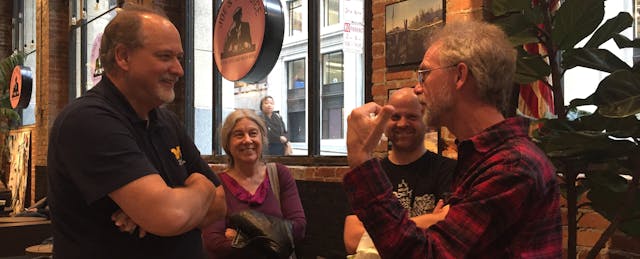Charles Severance was one of the first professors at the University of Michigan to give the massive open online courses (MOOC) platform Coursera a try. His first class was on internet history, technology and security. His passion for open access courses is rooted in his belief that the internet has an important role to play in education.
But while Severance—who’s better known by some as Dr. Chuck—says his first MOOC was a success, there was one thing about his in-person classes he missed: seeing his students. It’s a feeling he had even before the MOOC, and even before he was at the University of Michigan. Severance also taught an online course at Michigan State University in 1997. For that course, he had students take a face to face midterm.
“I just wanted to see their faces,” Severance tells EdSurge. “I’m making [the class] funny and making it engaging and teaching [students], but I don’t get to meet these people.”
So in 2012, the professor decided to take a common practice from his in-person courses, and invite MOOC students to global, online office hours. He’s now known for these office hours, along with a whimsical (and sometimes costume-clad) approach to teaching open online courses.
To get started with his MOOC open hours, Severance took a straightforward approach. “I just sent an email to 40,000 people, showed up at a Starbucks in New York City, and six people showed up,” he tells EdSurge.
Today, he’s met tons of his students all over the world through his online teaching and office hours, from Baltimore to South Korea. He usually hosts them at a local joint in whichever city he’s in. Last week, Severance hosted his office hours from a juice bar in San Francisco, where he met at least a dozen students, including Robert Mulder, a gas technical specialist who learned python from Severance’s MOOC. Mulder says he took the MOOC because he had to learn Python for his career.
“[The MOOC] was set up so nicely that I could download the lectures onto my Galaxy [device], hop on the bus, listen to all the lectures, get to work, take a test… in one day I've done two weeks worth of class,” Mulder says.
Severance points out that the University of Michigan School of Information, where he teaches, is not a computer science department—but it draws in students from a variety of backgrounds to learn to code.
“I teach programming to people who hate programming,” Severance said. “And so that’s why all my courses are for everybody, because I’m not saying programing for people who are good at calculus, I’m saying programming for everybody.”
To try to serve more students, Severance and his colleague, Colleen Van Lent, each have a new specialization on Coursera, which Coursera describes in part as a “series of rigorous courses.” Severance thinks that the combination those two new specializations—his on web applications, hers on learning how to design and create websites—with his programming for everybody course—would help take adult learners who know “absolutely nothing whatsoever to the point where a year and a half later, they can go apply for a job.”
He thinks that type of educational experience needs to be done fast, and without disrupting the lives of these students, who might have responsibilities such as children. That can be difficult, especially when students are trying to get a deeper learning experience.
“I think that we need a different kind of educational experience for an adult learner that wants to change the direction of their life from a career perspective,” Severance says.
Severance also notes that teaching programming through Coursea is much different than a bootcamp, which can cost upwards $10,000. Instead, a specialization can run from $39 to $79 a month, according to Coursera’s website.
Coursera assessments were free when Severance first started teaching on the platform, and he isn’t exactly a fan of company’s new revenue stream of charging students.
Severance claims he told Coursera’s co-founder Daphne Koller: “When Coursera told me that they were gonna force me to put a paywall said, well, that means I’m gonna put them up myself, and every time a student in my Coursera class complains about that, we’re going to point them at my site.”
Lessons from Dr. Chuck
Severance thinks the role of a MOOC professor similar to that of a cruise director on a ship. The professor works extensively behind the scenes to create a smooth experience, but tries to get people to “enjoy the experience.”
But when it comes to open office hours, he recognizes they aren't something all MOOC professors can pull off. For one, it requires confidence, and he compares the experience to “a blind date.” In fact, he said if his first few attempts at open office hours had failed, he might never have done it again.
Severance points out that gender can be a factor for faculty who want to do the kind of office hours he does, too. For instance, he thinks if a woman professor emails thousands of people, telling them to met her at a place such as a bar, it could be interpreted differently than if he does.
He thinks another way to connect with students is through “Teach Out” events, like an upcoming one he’s doing with Douglas Van Houweling. Severance said it will be “very live and agile” and will “only be a week.” What’s nice about this method is that it is “completely controlled.” There isn’t a “random, faraway location” involved.


